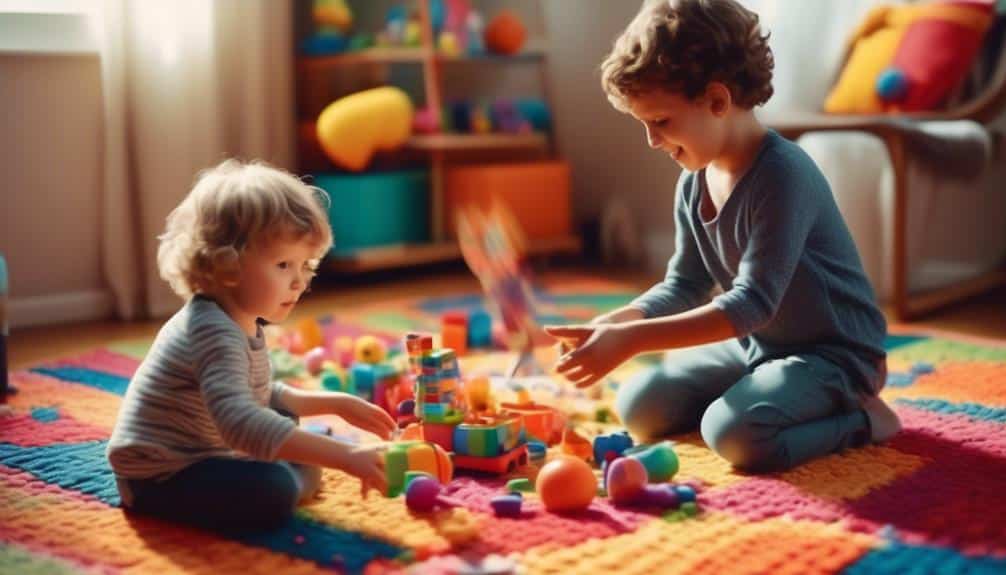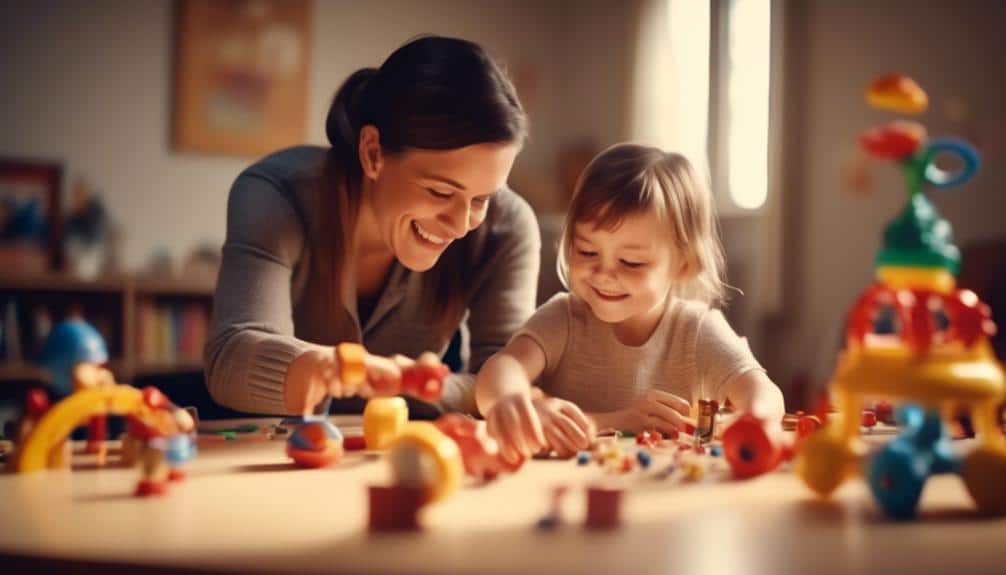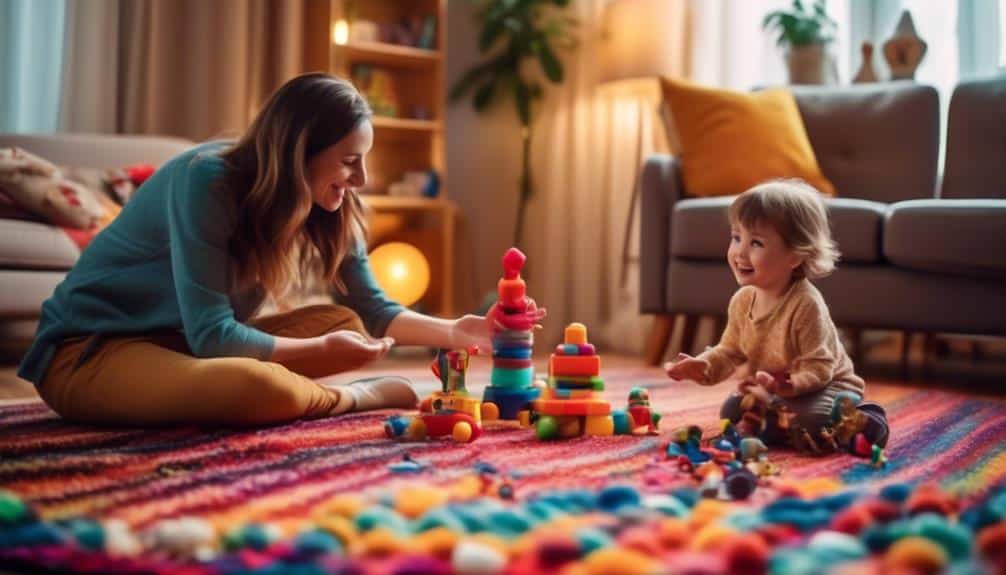The growing interest within the child development community is driven by the remarkable developmental strides achieved through the application of the DIRFloortime model, which, grounded in the principles of developmental and individual differences and relationship-based therapy, has been proven to foster significant advancements in children’s emotional and social development domains, exemplified by the positive impact of DIRFloortime outcomes. The review of outcomes associated with DIRFloortime interventions presents a compelling case for its efficacy, albeit alongside an acknowledgment of the necessity for more robust, high-quality research to further substantiate these findings.
Professionals in the field are encouraged to consider the nuanced facets of this approach, which underscore the importance of tailoring interventions to the individual child’s needs while maintaining a structured yet flexible framework. The insights gained from this review reinforce the model’s potential and highlight the critical need for practitioners to employ rigorous clinical reasoning and consistent intervention fidelity. As we move forward, the question remains: How can the successes of the DIR Floortime model be replicated and optimized to benefit a broader spectrum of children within diverse developmental contexts?
Key Takeaways
- DIR/Floortime is a developmental, individual differences, and relationship-based therapy approach that promotes a child’s development through natural emotions and interests.
- Parent engagement is crucial for supporting individual development and establishing deep emotional connections between children and caregivers.
- Tailored interventions based on the developmental level and individual differences and observational assessments guide practitioners in understanding the child’s profile.
- DIR/Floortime significantly improves social, emotional, and cognitive outcomes and enhances social interactions, communication skills, and mental development.
Understanding DIR/Floortime
The Developmental, Individual-differences, Relationship-based (DIR) Model, commonly known as DIR/Floortime, is an intervention that aims to promote a child’s development by leveraging their natural emotions and interests within an empathetic and evidence-informed framework. Established in the 1980s by Stanley Greenspan and Serena Wieder, the DIR/Floortime Model recognizes emotional development as the cornerstone for the progressive expansion of cognitive and communicative capacities in children, particularly those with autism spectrum disorders.
This intervention engages children through play and parent engagement, creating emotional and social growth opportunities. Parents and caregivers are encouraged to follow the child’s lead, tuning into their interests to create a supportive, nurturing environment that fosters learning and connection. A recent systematic review underscores the importance of systematic, quality research to ascertain the efficacy of DIR/Floortime. The review suggests that while positive perceptions of the model are evident, more rigorously designed studies are necessary to solidify its place as an evidence-based practice.
Occupational therapists, who often play a pivotal role in implementing the model, advocate for a minimum of 15 hours of intervention per week, adhering to the principle that intensity and consistency are vital to achieving meaningful Child Development Outcomes. While still in its infancy, the emerging evidence base holds promise for DIR/Floortime as a compassionate, responsive intervention strategy.
Core Principles in Action

Applying the DIR Floortime Model’s core principles begins with recognizing and respecting each child’s unique developmental trajectories and individual differences. Establishing deep emotional connections between children and their caregivers is fundamental to the model, fostering an environment where learning and growth can flourish. Research indicates that when these principles are meticulously implemented, they can significantly improve children’s social, emotional, and cognitive outcomes.
Embracing Individual Differences
Recognizing each child’s unique blend of strengths and challenges is foundational to the DIR/Floortime Model, which advocates for personalized intervention strategies that respect their developmental pathways. This evidence-based and empathetic approach ensures that therapy is tuned to the child’s emotional development. The model facilitates outcomes that reflect the child’s personal growth trajectory by prioritizing parent engagement.
- Tailored interventions adapt to each child’s developmental level and individual differences.
- Observational assessments guide practitioners in understanding the child’s unique profile.
- Parent engagement is crucial in supporting the child’s individual development within the family context.
- Outcomes are measured based on the child’s progress rather than a standardized norm, celebrating their unique achievements.
Embracing individual differences within the DIR/Floortime framework is not merely a method—it’s a commitment to the holistic well-being of each child.
Building Emotional Connections
Central to the DIR/Floortime Model is cultivating emotional connections, consistently enhancing a child’s developmental progress across multiple domains through interactive and playful engagement. This approach, essential for the emotional development of children, particularly on the autistic spectrum, emphasizes the importance of parent engagement in therapy. Through DIR/Floortime parent training intervention, caregivers learn to foster these crucial bonds, thus supporting their child’s social and emotional development. The model’s strategies are grounded in the developmental social pragmatic framework, encouraging children to relate emotionally in a meaningful and contextually appropriate manner. By building emotional connections, the model lays a strong foundation for children to navigate the complexities of emotional and cognitive landscapes, allowing for more fruitful interactions with their world.
Emotional Development Milestones

Developing the ability to navigate a complex emotional landscape, children reach significant milestones as they learn to identify, articulate, and manage their feelings while also becoming attuned to the emotions of others. This journey is particularly nuanced for Autistic children, who may experience the world with a unique intensity. Developmental approaches, such as the DIRFloor Time model, play a crucial role in guiding children with autism spectrum disorders through this process. This model explicitly addresses children’s emotional development, ensuring each milestone is met with tailored support.
Key emotional development milestones include:
- Recognition and Expression of Emotions: Developing the vocabulary to label emotions accurately and healthily express them.
- Regulation and Coping: Learning strategies to self-regulate emotions, especially during stressful situations, building resilience.
- Empathy and Social Understanding: Cultivating the ability to empathize with others and read social cues is vital for forming connections.
- Problem-Solving and Help-Seeking: Acquiring the skills to solve emotional challenges and understanding when and how to seek assistance.
For individuals dedicated to serving children with autism, these milestones are not just markers of growth but triumphs of emotional development, achieved through empathetic and analytical interventions.
Social Interaction Enhancements

Building upon the emotional development milestones achieved through the DIR Floortime Model, enhancements in social interactions manifest as observable growth in emotional sharing between children and their peers. This model facilitates the attainment of peer connection milestones, which are critical for a child’s social and emotional well-being. Interventions that focus on play-based interactions, supported by dedicated parental involvement, have shown promising results in strengthening the foundational social skills of children in early developmental stages.
Emotional Sharing Growth
Enhancing social interactions through the DIR Floortime Model, children experience significant growth in emotional sharing, a cornerstone for fostering meaningful connections with caregivers and peers. This growth is particularly impactful for children on the autistic spectrum, facilitating their social development in a nurturing and responsive environment.
- Parent engagement: Central to the process, encouraging sensitive attunement to children’s cues and fostering socio-emotional growth.
- The autistic spectrum: Tailored approaches to meet the unique needs of children with ASD, enhancing their capacity for emotional sharing.
- Social development: Children build vital social communication skills and relationships through increased emotional sharing.
- Functional Emotional Assessment Scale: Utilized to measure progress in emotional sharing, ensuring individualized and evidence-based interventions.
The DIR/Floortime approach’s empathetic and analytical framework supports a child’s ability to express and regulate emotions, which is essential for thriving in social contexts.
Peer Connection Milestones
While emotional sharing provides the bedrock for initial social engagement, achieving peer connection milestones significantly advances a child’s capacity for reciprocal social interactions. In early childhood, these milestones are particularly salient for children with autistic spectrum disorders, for whom social cues may not naturally resonate. Floor Time Play, rooted in developmental theory, is instrumental in guiding these children toward greater peer awareness. Evidence-based systematic reviews highlight the efficacy of parent engagement in DIR/Floortime, underscoring its value in enhancing social interaction. As milestones are reached, children exhibit enriched relationships, fostering inclusion and a sense of belonging amongst peers. These triumphs are a testament to the transformative power of tailored, empathetic approaches to child development.
Behavioral Changes Observed

Observing children who engage in DIRFloortime interventions, one can note significant improvements in their emotional regulation and capacity for social interaction. The therapy program has been particularly effective for autistic children, who often experience unique challenges in socio-emotional development. The intervention program emphasizes parent engagement and the floortime approach to help foster a nurturing environment conducive to positive behavioral changes.
The following list encapsulates the fundamental behavioral changes observed:
- Increased Prosocial Behavior: Children demonstrate enhanced social engagement, actively seeking interactions and shared experiences with peers and caregivers.
- Reduction in Repetitive Behaviors: With a focus on diverse play and interaction, there is a noticeable decrease in restrictive and repetitive behaviors, increasing adaptability.
- Enhanced Communication Skills: Notable improvements in both verbal and nonverbal communication allow for more effective expression and understanding, facilitating better connection with others.
- Emotional Connectedness: Children exhibit more profound emotional responses and greater sensitivity to the emotions of others, contributing to more meaningful relationships.
These outcomes are supported by valid outcome measures, ensuring that the observed changes are anecdotal and empirically validated. The DIR Floortime approach has thus proven to be a valuable intervention program for children’s holistic development.
Cognitive Skills Advancement

Frequently, the DIRFloortime Model is instrumental in advancing cognitive skills among children by addressing developmental gaps through interactive and playful learning experiences. This model is particularly significant for preschool children with autism spectrum disorder, who may face unique challenges in cognitive development. By engaging children in activities that align with their developmental levels, the DIR Floortime approach nurtures the growth of communication and adaptive skills essential for their cognitive advancement.
The systematic approach of the DIR/Floortime Model requires dedicated training for parents and clinicians who deliver this early intervention. A commitment to a minimum of 15 hours per week of this intervention is recommended to achieve meaningful progress. Children can build upon their functional capacities and overcome cognitive deficits through consistent and responsive engagement.
Evidence supporting the effectiveness of the DIRFloortime Model in enhancing cognitive skills is growing, but there remains a need for high-quality research to strengthen the evidence base. Using valid outcome measures is imperative to ensure that the cognitive gains are genuine and sustained. Regular monitoring allows for the assessment of individual progress and the fine-tuning of intervention strategies, thereby ensuring that each child’s unique cognitive journey is supported and celebrated.
Language and Communication Gains

The DIR/Floortime approach has been instrumental in nurturing children’s verbal and nonverbal communication skills, as evidenced by empirical studies. Enhanced verbal skills emerge as children engage in emotionally meaningful and cognitively stimulating play facilitated by a supportive adult presence. Moreover, significant breakthroughs in nonverbal communication are observed as children learn to use gestures, facial expressions, and eye contact to complement their growing linguistic abilities.
Enhanced Verbal Skills
Emphasizing emotional connections through play, the DIR/FloortimeTM Model has consistently demonstrated its effectiveness in enhancing children’s verbal and communication abilities. In pursuing child development, therapy is often part of a comprehensive plan that includes helping children refine their language capabilities. Notably, the DIR/FloortimeTM Model has been instrumental for children with autism spectrum disorder, yielding notable improvements in their expressive abilities.
- Significant improvements in verbal expression and receptive language
- Play-based interactions as a critical component for language development
- Parental involvement in therapy sessions correlates with better verbal outcomes
- Emotional development underpinning the acquisition of enhanced verbal skills
Employing the Emotional Assessment Scale (FEAS) and other use of valid outcome measures, therapists can document these advancements in an evidence-based manner, illuminating the model’s efficacy in speech therapy.
Nonverbal Communication Breakthroughs
Building on enhanced verbal skills, nonverbal communication breakthroughs in children using the DIR Floortime model mark another critical facet of language and communication gains. This floortime intervention fosters vital nonverbal cues such as eye contact, facial expressions, and gestures, essential for socio-emotional outcomes and overall child development. Caregivers and therapists promote a nuanced understanding of social cues and emotional expressions by engaging deeply with children, especially those with developmental disorders. Systematic reviews suggest that with consistent parent engagement in the treatment of children, the DIR Floortime approach can yield substantial improvements in nonverbal communication, setting a precedent for subsequent language acquisition and enriching children’s ability to connect with the world around them.
Parental Involvement Impact

Parental engagement in the DIR Floortime approach plays a pivotal role in enhancing the developmental trajectory of children, necessitating regular assessment to optimize its benefits. It is widely acknowledged that the parents’ active and consistent involvement in their young children’s developmental processes is crucial. When parents are equipped to use the systematic approach of DIR Floortime, they become integral contributors to the progress and well-being of their child.
- Systematic Approach: Parents trained in DIRFloortime use a systematic method to support their child’s development and learning through play and interaction.
- Use of Valid Outcome Measures: Assessing interventions with valid outcome measures is essential to determine the effectiveness associated with parent engagement.
- Casenhiser et al. Research: This work explains how structured parental involvement can lead to significant child developmental gains.
- Developmental Support: Parents are empowered to help the child navigate social, emotional, and cognitive milestones in a nurturing environment.
Empathy, analytical thinking, and evidence-based practice form the cornerstone of any intervention to foster growth in children. The impact of parental involvement in DIR Floortime is profound, and the commitment to using research-informed strategies, such as those advocated by Casenhiser et al., ensures that the development journey is scientifically sound and heart-led.
Case Study: Overcoming Challenges

While parental involvement is foundational in the DIR Floortime approach, a case study provides concrete evidence of how families navigate and surmount developmental challenges with this model. This particular case study highlights the journey of a family whose child was diagnosed with a pervasive developmental disorder. This model, emphasizing developmental and neurological progress through relational-based play, allowed significant strides in the child’s emotional functioning, communication, and daily living skills.
Through a systematic review of the child’s development, clinicians and parents implemented valid outcome measures to monitor progress, ensuring intervention fidelity regularly. The evidence base for the DIRFloortime Model, while still emerging, received a positive reception from the family involved, echoing the sentiments found in broader parent surveys. This case study underscores the importance of quality research and highlights the potential of the DIR Floortime Model in overcoming challenges associated with autism spectrum disorder (ASD).
The family’s dedication and a structured, evidence-based approach facilitated meaningful parent-child interactions and developmental gains. This case study serves as a testament to the impact of the DIR/Floortime Model and the resilience of families facing developmental disorders.
Long-term DIRFloorTime Outcomes Success Stories

The journey of growth in children with Autism Spectrum Disorder (ASD) often features pivotal milestones that mark substantial improvements in their social and cognitive domains. Evidence from longitudinal studies emphasizes the role of the DIR/FloortimeTM Model in fostering enhanced social engagement and advancing cognitive skills in these children. These success stories not only underline the model’s impact on child development but also highlight the resilience of families and therapists in navigating the complexities of ASD.
Enhanced Social Engagement
Numerous case studies have documented that children engaging with the DIR Floortime Model exhibit marked enhancements in social engagement, which often persist and flourish over time. This evidence-based approach fosters long-term social-emotional development, as outcomes were mostly reported through detailed long-term follow-up studies. Here are some key findings:
- Children learn to initiate and respond to social cues, leading to more meaningful circles of communication.
- Sustained improvements in social reciprocity and peer interactions were observed.
- Enhanced social engagement translated into better adaptive behaviors in various settings.
- Emotional development was significantly boosted, enhancing overall interaction in children.
These outcomes underscore the profound impact DIR Floor Time has on child development, affirming its importance in nurturing the social capacities of children.
Cognitive Skills Advancement
Moving beyond social engagement, children participating in DIR Floortime also experience significant strides in cognitive development, as evidenced by long-term studies tracking their progress. This is heartening news for those dedicated to serving children with developmental disorders, as it underscores the effectiveness of the DIR Floortime model in enhancing core cognitive skills. It is crucial to continue progressing the research base, as quality research is urgently needed to validate and refine this therapeutic approach further.
| Cognitive Area Improved | Study Findings |
|---|---|
| Language Development | Sustained growth in language abilities over time |
| Problem-Solving Skills | Enhanced capacity for complex thinking and reasoning |
| Attention Regulation | Improved focus and engagement in learning activities |
| Memory Function | Strengthened memory retention and recall capabilities |
| Generalization of Skills | Ability to apply learned concepts in various contexts |
Emerging from a published systematic review, these outcomes paint a promising picture for the long-term success of children receiving DIR Floortime interventions.
Educator Perspectives

Recognizing the complexities of child development, educators advocate for the DIR/Floortime model, citing its alignment with occupational therapy principles and its focus on nurturing emotional and intellectual growth in children. This model is particularly praised for its efficacy in engaging children with autism spectrum disorder (ASD) and other developmental and learning disorders, fostering increased socio-emotional capacities.
Educators highlight the following aspects of the DIR/Floortime model:
- *Intervention fidelity*: Ensuring that the DIR/Floortime model is applied consistently and accurately is crucial for its effectiveness.
- *Valid outcome measures*: Employing reliable assessment tools is essential for monitoring children’s progress and the impact of the intervention.
- *Family-centric approach*: Recognizing the family as the central support unit, the model involves parents and caregivers in therapeutic play, empowering them in the developmental process.
- *Need for high-quality research*: A systematic review of the DIR/Floortime approach is necessary to solidify its evidence base and guide best practices.
Educators understand that the path to helping children with developmental challenges is multifaceted. Through empathy and analysis, they underscore the importance of evidence-based interventions like DIR/Floortime, prioritizing relational play, and developmentally appropriate engagement to support children in reaching their full potential.
Therapeutic Techniques Demonstrated

Delving into the heart of the DIR/FloortimeTM model, therapeutic techniques such as individualized assessment and interactive play sessions are pivotal in addressing the unique developmental needs of each child. This model used in child development fosters socio-emotional improvement through a dynamic process that integrates various strategies tailored to each individual.
At its core, the DIR/FloortimeTM approach advocates for active parent involvement, recognizing parents as integral to the therapeutic framework. This involvement empowers families and ensures consistency and continuity in therapeutic practices. Problem-solving interactions and the creative arts therapies program function as conduits for expressing and interpreting the emotional experiences of children, particularly those with autism spectrum disorder.
Therapists are tasked with crafting a nurturing environment where children can explore and learn at their own pace. The therapeutic techniques administered require a commitment to at least 15 hours per week of combined parent and clinician-led interventions, grounded in robust clinical reasoning and validated by reliable outcome measures. Such diligence ensures the model’s integrity, enabling children to achieve developmental milestones across emotional, sensory, motor, cognitive, and communicative domains.
Play-Based Strategy Benefits

Building upon the therapeutic techniques outlined earlier, the efficacy of play-based strategies in the DIR/Floortime Model emerges as a cornerstone for fostering developmental progress across multiple domains in children. The systematic review of intervention outcomes reveals significant social-emotional improvement when children engage in structured and spontaneous play. This finding is crucial given the integral role of emotional regulation in overall child development.
Play-based strategies within the DIR Floor Time framework are designed to be empathetic and responsive to each child’s unique needs, promoting learning and forging strong bonds between the child and caregiver. Parent involvement is crucial, as it encourages consistency and reinforcement of positive behaviors within the home environment.
The benefits of a play-based strategy in child development include:
- Enhanced Sensory and Motor Skills: Children refine their sensory perception and motor abilities through playful interaction.
- Emotional and Cognitive Growth: Play encourages exploration and problem-solving, contributing to emotional resilience and intellectual development.
- Communication Milestones: Play helps children develop language and mutual communication skills.
- Social Connections: DIR Floor Time facilitates relationship-building with peers and adults, fostering social competence.
Integrating DIR in Daily Routines

Incorporating the principles of the DIR/Floortime model into daily routines offers a seamless approach to enhancing children’s developmental trajectory through consistent, play-based interactions. This systematic approach to child development emphasizes integrating emotional and socio-emotional growth within the fabric of everyday life. By engaging in DIR Floor Time, parents and caregivers actively support their child’s exploration and learning, making every interaction an opportunity for development.
Parent involvement is crucial in this model, particularly for children with autism, as it fosters a deeper understanding and responsiveness to their child’s unique cues and needs. Training for parents equips them with the skills needed to embed these therapeutic interactions into daily routines, promoting cognitive, communication, and motor skill development.
The evidence points to the benefits of consistent intervention fidelity, which entails regular, intentional DIR Floor Time sessions and monitoring progress to ensure the approach effectively supports the child. When integrated thoughtfully, DIR Floor Time becomes more than just a therapy session; it transforms daily routines into enriching experiences that contribute to the child’s capacity to relate, communicate, and think. This integration supports children in reaching their developmental milestones and strengthens the emotional bond between parent and child.
Frequently Asked Questions
Who Benefits From DIRfloortime?
DIR Floortime benefits children with developmental disorders by enhancing emotional, social, and cognitive skills. Parents, caregivers, and professionals also gain valuable tools for fostering meaningful engagement and intervention with these children.
Is DIR/Floortime Therapy Evidence-Based?
Floortime therapy, while promising, remains a tapestry with threads of evidence yet to be entirely woven into the robust scientific fabric required for universal endorsement as an evidence-based practice in child development.
What Is the Dirfloortime Approach?
The DIRFloortime approach is a developmental intervention that enhances foundational emotional and social capacities through play and relationships, emphasizing individual differences and promoting engagement between caregivers and children with developmental challenges.
What Are the Principles of DIRFloortime?
The principles of Floortime center on fostering emotional and intellectual growth through interactive play, tailoring interventions to individual developmental profiles, and nurturing relationships that scaffold the child’s experiences in a secure, empathetic environment.
Conclusion
autism spectrum disorders affect the life and behavior of children with developmental disabilities. Longitudinal studies suggest that behavioral interventions are the most effective means of improving the well-being of autistic children. A study published in the Journal of Child Psychology and Psychiatry by Koegel et al. showed that children who receive early intervention for autism spectrum disorders show significant improvements in adaptive functioning and emotional well-being.
The study followed children with autism from when they were 18 months of age to when they were five years old. The children who received intervention programs for children with autism showed better outcomes for children than those who did not receive intervention. The evidence-based treatments recommended by the American Journal on Mental Retardation, the American Psychological Association, and the American Psychiatric Association showed positive results in empirical studies.
Poor muscle development is joint in children with disabilities, and physical therapy milestones are essential indicators of progress. The treatment of autism requires a comprehensive approach that considers the quality of life of the child with autism and their families. Programs for children with autism should focus on real-life situations to ensure that the child develops typical behavior. The Journal of Autism and Developmental Disorders also recommends that intervention for children with autism should include practices for children and manuals for parents.
Developing children are not the only ones who benefit from early intervention. Intervention in parents also has positive parent outcomes. A study by the American Academy of Pediatrics showed that mothers of children with autism who receive intervention have better maternal well-being than those who do not. Occupational therapy milestones are also essential in measuring the progress of autism interventions.
Stressful life events can also affect the well-being of children with autism spectrum disorders. Therefore, it is crucial to provide effective interventions that address the child’s and their families’ needs. With the right interventions and support, children with autism spectrum disorders can develop adaptive behavior and improve their quality of life.


Recent Comments